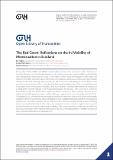Files in this item
The red gown : reflections on the in/visibility of menstruation in Scotland
Item metadata
| dc.contributor.author | Røstvik, Camilla Mørk | |
| dc.contributor.author | Hughes, Bee | |
| dc.contributor.author | Spencer, Catherine | |
| dc.date.accessioned | 2022-03-03T12:30:18Z | |
| dc.date.available | 2022-03-03T12:30:18Z | |
| dc.date.issued | 2022-03-03 | |
| dc.identifier | 278130523 | |
| dc.identifier | e9699594-f9a2-41fa-a30b-143656062500 | |
| dc.identifier | 000765508400001 | |
| dc.identifier | 85128815478 | |
| dc.identifier.citation | Røstvik , C M , Hughes , B & Spencer , C 2022 , ' The red gown : reflections on the in/visibility of menstruation in Scotland ' , Open Library of Humanities , vol. 8 , no. 1 . https://doi.org/10.16995/olh.6340 | en |
| dc.identifier.issn | 2056-6700 | |
| dc.identifier.other | crossref: 10.16995/olh.6340 | |
| dc.identifier.other | ORCID: /0000-0002-9359-7357/work/109316229 | |
| dc.identifier.other | ORCID: /0000-0001-9916-917X/work/109316240 | |
| dc.identifier.uri | https://hdl.handle.net/10023/24989 | |
| dc.description.abstract | During the 1990s, 2000s and 2010s, menstruation became more present in public discourse in Scotland. Despite this, little attention has been paid to the complex interplay of visibility and invisibility that characterises menstruation’s place in the nation’s wider cultural landscape. In this article, we explore the context of menstruation in the town of St Andrews specifically and Scotland more broadly, during the late 20th and early 21st century, and ask what this reveals about menstrual absence and presence in public debates. The University of St Andrews lies at the centre of this case study because it has been one of the Scottish institutions that has initiated a rollout of free menstrual products as a result of the Period Products (Free Provision) (Scotland) Act of 2021. The University’s Centre for Contemporary Art also hosted Bee Hughes as artist-in-residence, whose practice focuses on the visible and invisible aspects of menstruation. Although impacted by a university strike and the Covid-19 pandemic, our collaboration has explored collections of menstrual culture in Scotland and broader questions of menstrual representation, reflecting on how established symbols with other connotations (notably the ceremonial red gown at the University of St Andrews) might provide a way of thinking about menstrual in/visibility. In this article, we discuss how these histories might be both present (institutionalised) and absent (when not on display). This paper presents our findings, in which the artist documents their first visit to St Andrews prior to the strike and pandemic, in relation to historical and contextual materials we located together. | |
| dc.format.extent | 23 | |
| dc.format.extent | 4359415 | |
| dc.language.iso | eng | |
| dc.relation.ispartof | Open Library of Humanities | en |
| dc.subject | Contemporary art | en |
| dc.subject | Feminist art history | en |
| dc.subject | 1990s feminism | en |
| dc.subject | Scottish women's movement | en |
| dc.subject | Menstruation | en |
| dc.subject | N Visual arts (General) For photography, see TR | en |
| dc.subject | H Social Sciences (General) | en |
| dc.subject | NDAS | en |
| dc.subject | SDG 5 - Gender Equality | en |
| dc.subject | MCC | en |
| dc.subject | NCAD | en |
| dc.subject.lcc | N1 | en |
| dc.subject.lcc | H1 | en |
| dc.title | The red gown : reflections on the in/visibility of menstruation in Scotland | en |
| dc.type | Journal article | en |
| dc.contributor.institution | University of St Andrews. Centre for Contemporary Art | en |
| dc.contributor.institution | University of St Andrews. School of Art History | en |
| dc.identifier.doi | 10.16995/olh.6340 | |
| dc.description.status | Peer reviewed | en |
This item appears in the following Collection(s)
Items in the St Andrews Research Repository are protected by copyright, with all rights reserved, unless otherwise indicated.

